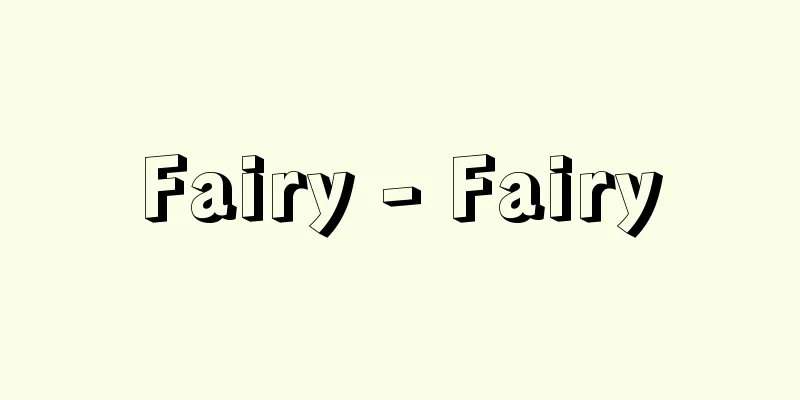Fairy - Fairy

|
They are supernatural beings who live in a world close to the human world and can change shape at will. Their characteristics such as beauty, size, goodness and evil vary greatly depending on the region and era, but in general they have a very human appearance and nature, often lacking conscience and integrity, being fickle, exaggerating in return for kindness from humans, and taking terrible revenge if they are teased. Until the early modern period, they were feared as being somewhat evil, but they have been romanticized in fairy tales and cartoons. The English word fairy, the French word fée, and the German word Fee all come from the Latin word fatum, which means the goddess of fate, and convey a semi-divine character. Therefore, the beautiful female nymphs who live in the sea, rivers, springs, forests, and hills in Greek mythology, and the half-woman, half-bird sirens who seduced Odysseus, can also be included in the category of fairies. Other examples of fairies that could be considered fairies include the angel-like flying Peri in Persian mythology, the extremely ferocious Babarijaga in the Slavic world, the hideous, giant trolls of Scandinavia, Japan's Sudama (tree spirits or mountain spirits), and the Koropokkuru of Ainu legend. The Robin Goodfellow (also known as Puck) of England, the Brownie of Scotland, and the Kobold of Germany are said to live in or near houses and secretly work there at night. The Pixie, which lives in Cornwall, is a wayward little person commonly known for wearing a red pointed hat and green clothes, and is said to be the soul of an infant who died before baptism. The Leprechaun of Ireland is a shoemaker's fairy who always makes one shoe, and there is also a Banshee, a female spirit dressed in green and with a gray cloak, who is said to cry while washing the clothes of those who are destined to die on the riverbank, and people fear that if they hear her voice, someone will die nearby. The Kelpie, which has the form of a horse, lives in Scotland and drags travelers into the water and turns water wheels at night. Fairies called Gnome or Knocker live underground and are said to guard treasures underground and tell people where ores are located. There are many interpretations of the existence of fairies, including that they are indigenous people who lived before the ruling races, pagan gods who were oppressed by the arrival of Christianity, or inhabitants of the world of the dead. However, the image of good and kind fairies, or cute and beautiful fairies, is a product of fairy tales, children's stories, and comics from the early modern period onwards, and until then, they were viewed as being similar to devils and witches and were extremely feared. In particular, there was a deep-rooted fear of changelings, in which newborn babies were kidnapped and turned into fairy babies. In Arthurian legend, the king's sister, Morgan le Fay, is a fairy who helps the king with her magical powers, and she also appears in Ariosto's Orlando Furioso. Fairies play leading roles in Spenser's The Fairy Queen and Shakespeare's A Midsummer Night's Dream. Unexplained plane crashes during World War II were often blamed on a new breed of sprites called gremlins. [Hideo Funato] Source: Shogakukan Encyclopedia Nipponica About Encyclopedia Nipponica Information | Legend |
|
人間界に密接した世界に住み、変幻自在の超自然的な存在。その美醜、大小、善悪などの性状は地域や時代によって甚だ異なるが、一般にはきわめて人間に近い姿や性質をもち、良心や節操に欠けることが多く、気まぐれで、人間からの親切には大げさな返礼をし、じゃけんにされると手ひどい仕返しをするという。近世まではどちらかといえば邪悪な存在として恐れられたが、童話や漫画によって美化されてしまった。英語のフェアリーfairy、フランス語のフェféeやドイツ語のフェーFeeなどは、ラテン語のファトゥムfatumつまり運命の女神に由来し、半神的性格を伝えている。したがって、ギリシア神話に登場する海、川、泉、森、丘などに住む美しい女精ニンフや、オデュッセウスを誘惑した半女人半鳥のセイレンも妖精のなかに含めることができよう。ペルシア神話では天使のように飛翔(ひしょう)するペリ、スラブ世界では凶悪このうえないババリジャガ、スカンジナビアの醜悪・巨大なトロール、そしてわが国のすだま(木の精や山の霊)、アイヌ伝説のコロボックルなども妖精と考えられよう。 イングランドのロビン・グッドフェロー(別名パック)、スコットランドのブラウニー、ドイツのコボルトなどは、人家もしくはその近くに住み、夜になると人知れずその家の仕事をするといわれる。コーンウォールにすむピクシーは気まぐれな小人で、赤いとんがり帽子に緑の服を着た姿で一般に知られ、一説に洗礼前に死んだ嬰児(えいじ)の魂という。アイルランドのレプラコーンはいつでも片方の靴だけをつくっている靴屋の妖精であり、また同地には緑衣をまといグレーのマントを羽織った女精バンシーがいて、死ぬ運命になった人の服を川岸で洗いながら泣くといわれ、その声が聞こえると身近に死者が出ると人々は恐れた。馬の姿をしたケルピーはスコットランドに住み、旅人を水の中に引きずり込んだり、夜、水車を回したりする。ノウムとかノッカーとかいわれる妖精は地中にいて、地中の宝を守ったり、鉱脈のありかを知らせたりするという。 妖精の存在については、支配民族の前に住んでいた原住民、キリスト教の到来によって抑圧された異教の神々、死の世界に住む住人たちなどいろいろな解釈がなされている。ただ善良で親切な、またはかわいく美しい妖精の姿は、近世以後のおとぎ話、童話、漫画などの所産であって、それまでは悪魔や魔女と同類視され、きわめて恐れられた存在であった。とくにチェンジリングといって、生まれたばかりの嬰児がさらわれ、妖精の子とかえられてしまうという恐怖が根強くあった。 アーサー王伝説で、王の妹モルガン・ル・フェーは魔力によって王を助ける妖精であり、アリオストの『狂えるオルランド』にも登場する。スペンサーの『妖精女王』、シェークスピアの『真夏の夜の夢』では妖精が主役的役割を果たしている。 第二次世界大戦中の原因不明の飛行機事故は、しばしばグレムリンという新参の妖精のせいといわれた。 [船戸英夫] 出典 小学館 日本大百科全書(ニッポニカ)日本大百科全書(ニッポニカ)について 情報 | 凡例 |
>>: Larva - Fairy (English spelling)
Recommend
Kuroda family
(1) The family is a branch of the Uda-Genji Sasaki...
Hie Shrine
A shrine located in Nagatacho, Chiyoda Ward, Tokyo...
ANSI - Ansi
American National Standards Institute. A non-profi...
Villancico
…It is a general term for religious folk songs su...
Watari [town] - Watari
A town in Watari County, in the southern part of M...
Sedum telephium (English spelling)
… [Hiroshi Yuasa]. … *Some of the terminology tha...
Japan Times (English)
…After the war, it played a major role in informi...
American Free Trade Association
...The United States launched the Alliance for Pr...
Zenobia (English spelling)
[raw]? [Died] Queen of the ancient caravan city-st...
A petition to the emperor
Under the modern Emperor System (Meiji Constituti...
The crossroads of Karu-Morokoshi - The crossroads of Karu-Morokoshi
...One of the ancient Japanese markets. The inter...
"Local Medicines for the Prevention of Diseases" - Kyoyaku Saisei Shuseiho
…85 volumes. Based on the compilation of traditio...
Antihistamines - Antihistaminics
A drug that specifically antagonizes histamine. H...
boundary value problem
…Differential equations generally have an infinit...
Volcanic Emissions
A liquid or solid fragmented material released in...









